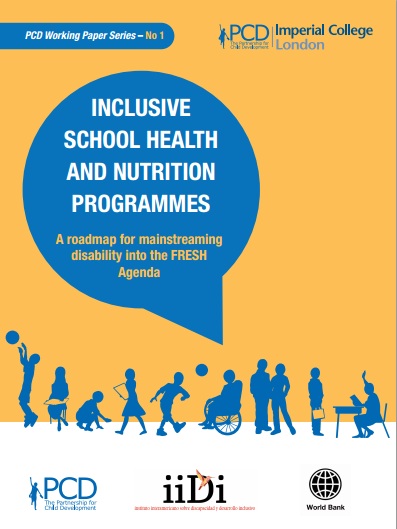According to the World Health Organisation, approximately 93 million children in the world – 1 in 20 children aged 14 or younger – have a moderate or severe disability. The majority of them live in low- and middle-income countries, are not enrolled in school and have very poor access to the most basic health and nutrition opportunities. Whether it is due to poor data or a lack of knowledge and understanding school health and nutrition (SHN) policy makers and programmers have previously struggled to visualize this group and respond effectively to their needs. These children have been left behind.

To help tackle this and provide policy makers and programmers with practical research that they can use to develop and implement inclusive SHN programme the Partnership for Child Development from Imperial College London have released Inclusive SHN programmes: A roadmap for mainstreaming disability into the FRESH agenda. This new working paper brings together the evidence and best practice from around the globe to provide practical examples of how develop SHN programmes that address the needs of children with disabilities and identify and overcome some of the common barriers to inclusion.
The paper identifies that children with disabilities face a range of physical and social barriers which prevent them from accessing health and education services, these include inaccessible school buildings and physical resources but can also include issues such as poverty and social determinants including class and gender, which work together to lock these children out. Another obstacle is the low expectations placed on these children by families, teachers and health personnel. Rooted in social stigma these expectations wrongly reject the proposition that children with disabilities can live a healthy and educated life.
Inclusive approaches to education and health are required to ensure equal rights and opportunities, personal autonomy and dignity to all children, regardless of their social status, gender, age, physical or mental condition, race, religion or sexual orientation. The 2007 ratification of the International Convention on the Rights of Persons with Disabilities which calls on countries to develop inclusive policies and programmes has had significant global impact on equality but we also need to ensure that disability is fully integrating into the post 2015 development agenda as part of the broader strategy for achieving equity. Tools such as the PCD working paper which enable governments to development and implement inclusive programmes are a small but integral part of this process.
The Story of Chung Lang
 Chung Lang, a 13-year-old 5th grader in Siem Reap, Cambodia, lost vision in her right eye due to vitamin D deficiency. Poor vision in her left eye made it very difficult for her to see the teachers’ writing on the blackboard. She persevered in school mostly relying on her hearing. But eventually, she dropped out of school.
Chung Lang, a 13-year-old 5th grader in Siem Reap, Cambodia, lost vision in her right eye due to vitamin D deficiency. Poor vision in her left eye made it very difficult for her to see the teachers’ writing on the blackboard. She persevered in school mostly relying on her hearing. But eventually, she dropped out of school.
Now, with a pair of new glasses through a school-based vision screening programme, Chung Lang says, “I really enjoy reading.” A $2 pair of glasses determined whether or not this young girl goes to school and receives an education.
About 13,000 children in 56 schools in Siem Reap province were part of the school-based vision screening initiative which was implemented by the Cambodian Ministry of Education, Youth and Sports with support from the Global Partnership for Education, the Partnership for Child Development, Sightsavers and the World Bank during 2012. Many children received eye glasses; a few were referred for eye surgery or for other treatments related to vision problems. For most children, it was their first vision screening and their first pair of glasses.
The results of the project provided valuable input for strategic planning discussions with the ministry of education and led to increased support for excluded children.
Further information

